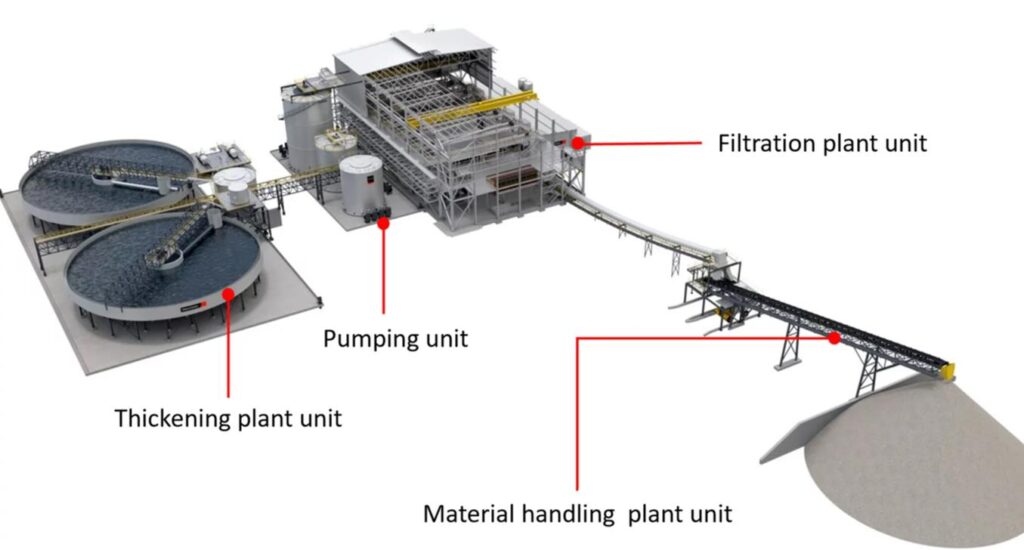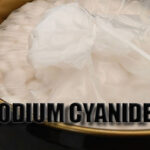
Cyanide tailings, generated after flotation and cyanidation of gold concentrates, exhibit complex mineralogy and chemistry, varying by ore type and processing route. Key characteristics include:
- Metal Minerals:
- Primary sulfides: Pyrite (FeS₂) dominates, with minor chalcopyrite (CuFeS₂), galena (PbS), and sphalerite (ZnS).
- Gangue Minerals:
- Quartz (SiO₂) is predominant, alongside chlorite, mica, feldspar, and kaolinite.
- Chemical Residue:
- Contains residual cyanide (CN⁻) and processing reagents, often with fine-grained (<0.045mm) particles and high mud content.
Core Challenges in Tailings Recovery
Three critical factors complicate metal recovery from cyanide tailings:
- Ultra-Fine Particle Size & Colloidal Behavior
- Over 95% of particles may be -0.045mm, forming a colloidal dispersion that hinders flotation separation.
- High specific surface area increases reagent adsorption, reducing selectivity.
- Mineral Inhibition from Cyanidation
- Cyanide forms stable complexes with metal surfaces (e.g., Cu-CN, Fe-CN), suppressing natural hydrophobicity.
- Prolonged aeration during cyanidation further oxidizes mineral surfaces, diminishing floatability.
- Pulp Chemistry Interference
- Argillaceous silicates (e.g., kaolinite) consume collectors and depress valuable minerals.
- Residual CN⁻ and dissolved metals (e.g., Cu²⁺, Fe³⁺) destabilize flotation froths and compete with collectors.
Targeted Recovery Strategies
1. Copper and Sulfur (Pyrite) Recovery
- Rationale: Chalcopyrite is the primary recoverable copper mineral, while pyrite can be recycled as a sulfur source or neutralizing agent.
- Process Steps:
- Regrinding: Optimize to -0.038mm to liberate locked chalcopyrite from gangue.
- Depression of Pyrite: Use lime (CaO) to raise pH to 10–11, suppressing pyrite while activating chalcopyrite with copper sulfate (CuSO₄).
- Flotation: Employ xanthate-based collectors (e.g., sodium isobutyl xanthate) for copper sulfide flotation.
- Outcome: Achieve copper concentrates with 18–22% Cu grade at 70–80% recovery.
2. Mitigating Colloidal and Chemical Interferences
- Desliming Pre-Treatment:
- Use hydrocyclones or centrifuges to remove <20μm slimes, reducing reagent consumption.
- Cyanide Degradation:
- Apply in-line chlorination (e.g., Ca(ClO)₂) or peroxide (H₂O₂) to decompose CN⁻ before flotation.
- Pulp pH Control:
- Adjust to neutral-to-alkaline pH (8–10) to minimize argillaceous mineral swelling.

Operational Considerations
| Challenge | Mitigation Strategy |
|---|---|
| Fine particle flocculation | Use dispersants (e.g., sodium silicate) to deflocculate. |
| Cyanide residual | Pre-treat with activated carbon or biological degradation. |
| Oxidized mineral surfaces | Use strong collectors (e.g., dithiophosphates) or reductive agents (e.g., SO₂). |
| High mud content | Implement stage-wise flotation with multiple cleaning steps. |
Economic and Environmental Benefits
- Cost Efficiency: Recovering copper and sulfur offsets processing costs, with payback periods often <18 months for retrofitted circuits.
- Sustainability: Reduces cyanide discharge risks and minimizes tailings volume, aligning with circular economy goals.
- Regulatory Compliance: Pre-treating tailings for cyanide and metal removal ensures adherence to strict effluent standards.
Actionable Steps for Mine Operators
- Tailings Characterization:
- Conduct mineralogical analysis (e.g., SEM-EDS, XRD) and cyanide speciation testing to design tailored flowsheets.
- Pilot Testing:
- Evaluate flotation parameters (reagent dosages, pH, grind size) on representative tailings samples.
- Technology Partnerships:
- Collaborate with suppliers of advanced flotation reagents (e.g., cyanide-degrading agents) or fine-particle separation equipment.




